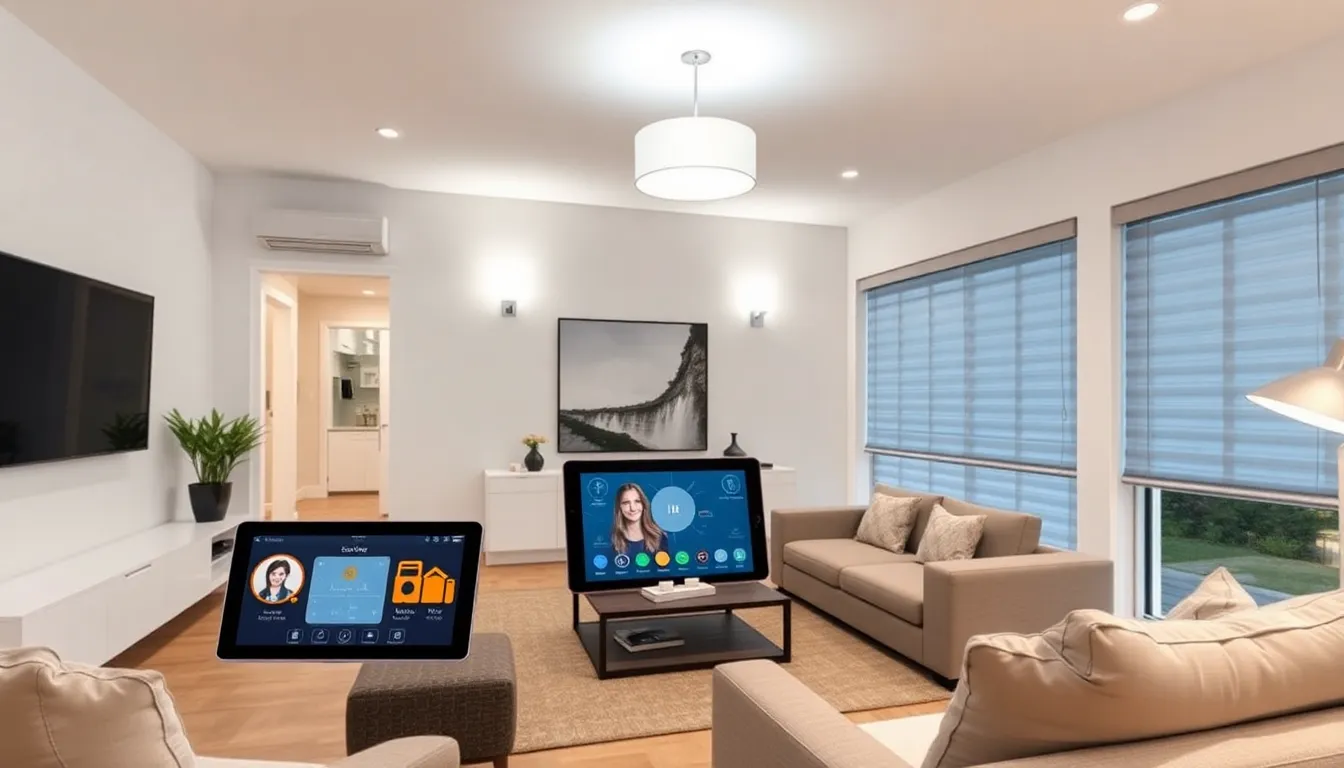Imagine walking into your home and having the lights turn on automatically, the thermostat adjust to your perfect temperature, and your favorite playlist start playing—all without lifting a finger. Welcome to the world of home automation, where technology takes the wheel and everyday tasks become a breeze. It’s like having a personal assistant, but without the awkward small talk.
Table of Contents
ToggleWhat Is Home Automation?
Home automation refers to the use of technology to control various household systems remotely. Through smart devices, individuals can manage lighting, security, heating, and other functions from their smartphones or tablets. This system enhances convenience by automating daily tasks that usually require manual effort.
Devices in a home automation setup include smart thermostats that adjust temperature based on user preferences. Security cameras monitor property activity, sending alerts to users when motion is detected. Smart lighting systems allow for control of brightness and color settings, creating the desired ambiance effortlessly.
Integration of these devices contributes to energy efficiency. For instance, smart plugs can schedule the operation of appliances, reducing energy consumption during peak hours. Homeowners can also monitor usage patterns, leading to informed decisions on energy-saving practices.
Advantages extend to security features. Automated door locks provide remote access, allowing homeowners to manage entry, even when away. Furthermore, systems can simulate occupancy by controlling lights and entertainment systems, deterring potential intruders.
Customization plays a key role in home automation. Users can create specific routines, adjusting devices based on time of day or personal habits. For example, a morning routine might gradually increase light levels and activate coffee makers.
Home automation simplifies life, maximizes comfort, and enhances safety. By adopting smart technologies, individuals create environments that adapt to their needs, leading to a more efficient lifestyle.
Benefits of Home Automation

Home automation offers several advantages that enhance the quality of life. This technology streamlines everyday tasks, making homes smarter and more efficient.
Increased Convenience
Automation simplifies daily routines significantly. Smart lighting, for instance, activates at set times, eliminating the need for manual operation. Home devices can respond to voice commands, allowing hands-free control. Additionally, scheduling appliances reduces the hassle of remembering to turn them off. Users appreciate the ability to manage systems remotely through smartphones or tablets, helping to address issues instantly. Homeowners can receive alerts about system malfunctions or security breaches, enhancing overall convenience.
Enhanced Security
Security becomes more robust with home automation. Automated door locks enhance safety by allowing keyless entry. These locks can be controlled via mobile applications, providing remote access. Security cameras integrated into the home system offer real-time monitoring and alert users to unusual activities. Smart lighting can simulate occupancy when residents are away, deterring potential intruders. Furthermore, motion sensors trigger alerts, allowing immediate action if needed. Enhanced security features provide peace of mind for homeowners.
Energy Efficiency
Energy efficiency improves through smart home technology. Smart thermostats optimize heating and cooling by adjusting settings based on occupancy. This capability helps reduce energy consumption and lowers utility bills. Automated blinds adjust to sunlight, minimizing reliance on artificial lighting. Homeowners can monitor energy usage in real-time, identifying areas for improvement. Utilizing energy-efficient appliances further enhances overall efficiency. Together, these strategies lead to a significant reduction in energy costs while promoting sustainability.
Key Components of Home Automation
Home automation involves several key components that work together to create a seamless living environment. Understanding these components helps maximize benefits and ensure effective integration.
Smart Devices
Smart devices serve as the backbone of home automation. These gadgets include smart thermostats, security cameras, and smart lighting systems. Each device connects to the internet, enabling remote access and control. Smart thermostats adjust temperatures based on user preferences, contributing to energy efficiency. Security cameras allow for real-time monitoring, enhancing home safety. Smart lighting systems adjust brightness based on time of day or occupancy, promoting convenience. Together, these devices streamline daily tasks, making life more manageable and efficient.
Central Hubs
Central hubs act as the command center for home automation systems. These hubs manage communication between smart devices and enable users to control everything from a single interface. They support various protocols, allowing different brands and types of devices to work together. Users can program routines that automate multiple devices, resulting in synchronized operation. Central hubs often connect to smartphones or tablets, offering remote access to home systems. User-friendly interfaces simplify management, ensuring an intuitive experience.
Popular Home Automation Systems
Several home automation systems stand out in the market today. SmartThings fosters seamless integration of various smart devices, making it versatile for many households. Google Nest provides powerful connectivity, allowing users to control devices through voice commands with Google Assistant. Amazon Alexa offers a comprehensive ecosystem, enabling users to connect and manage numerous devices with ease.
Apple HomeKit focuses on security and privacy, allowing users to create personalized automation routines across different smart devices. Tuya Smart serves as a popular choice for budget-conscious consumers, supporting a wide array of products while ensuring ease of use. Philips Hue specializes in smart lighting, offering customizable color options and energy-efficient solutions.
Wink provides a user-friendly interface that makes it easy to set up and manage devices. IFTTT (If This Then That) enhances automation by linking different services and devices, creating customized workflows that suit individual needs. Control4 targets users who seek a more sophisticated, whole-home solutions, allowing for extensive customization and programming.
Home Assistant is an open-source platform that enables advanced users to build their own home automation systems, offering great flexibility and control. Ring, primarily known for security cameras, also integrates with various smart home devices for enhanced monitoring and security features. Each of these systems offers distinct features that cater to different user preferences, ensuring that homeowners can find the right solution for their automation needs.
Future Trends in Home Automation
Emerging trends in home automation focus on increased integration and intelligence. Voice-activated assistants enhance user interaction, allowing homeowners to control devices through simple commands. Expanding connectivity with Internet of Things (IoT) devices enables seamless control over household systems.
Data-driven insights will shape automation features based on user preferences. Predictive analytics help devices anticipate needs, optimizing efficiency and convenience. Energy management systems will play a crucial role in monitoring and reducing energy consumption, aligning with sustainable practices.
Security will advance significantly with AI-based threat detection. Smart cameras will become more sophisticated, identifying unusual activity and notifying homeowners in real-time. Enhanced privacy features will address security concerns, ensuring data protection as automation expands.
Interoperability among devices will ease the integration process. Supporting multiple communication protocols will allow diverse devices to work together seamlessly. This compatibility ensures a more cohesive user experience.
Customization options will also evolve, enabling tailored routines that adapt to lifestyle changes. Homeowners can create personalized scenarios that reflect their needs, enhancing the overall living experience.
Finally, augmented reality (AR) and virtual reality (VR) may offer innovative control methods for smart homes. Visualizing device settings in real-time could simplify interaction, allowing homeowners to manage their environments intuitively. As technology progresses, home automation will become increasingly dynamic and user-friendly, transforming everyday living.
Home automation represents a significant leap in how individuals manage their living spaces. By integrating smart technology into everyday tasks, it not only enhances convenience but also boosts security and energy efficiency. As innovations continue to emerge, homeowners can expect even greater customization and intelligence in their systems.
With the ability to control devices from anywhere and the promise of predictive capabilities, home automation is set to redefine modern living. Embracing these advancements allows users to enjoy a streamlined lifestyle that adapts to their unique needs, making home automation an essential component of contemporary homes.


